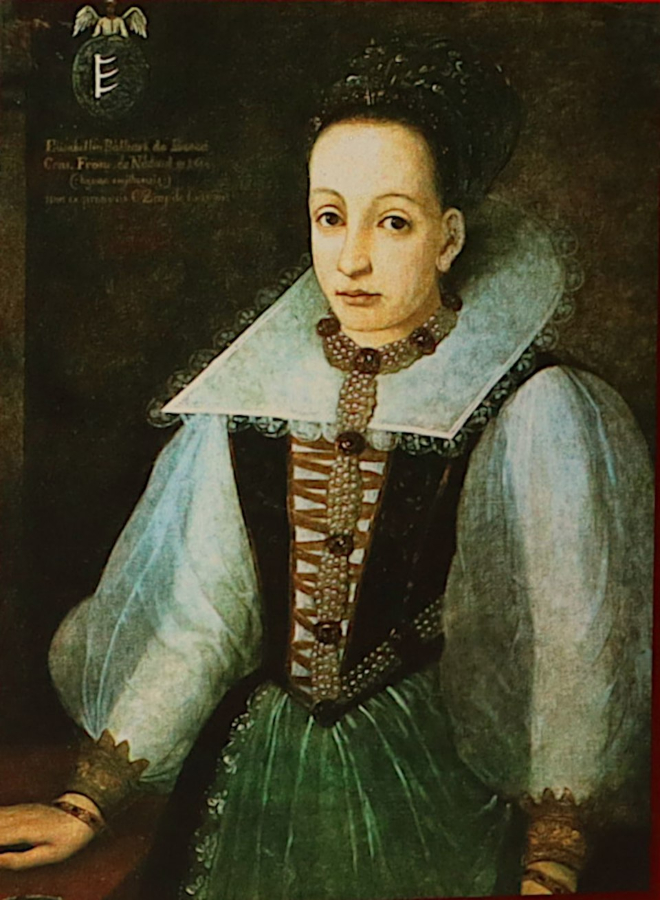Countess Elizabeth Báthory de Ecsed (7 August 1560 – 21 August 1614) was a Hungarian noblewoman and alleged serial killer from the family of Báthory, who owned land in the Kingdom of Hungary (now Slovakia). Báthory and four of her servants were accused of torturing and killing hundreds of girls and women between 1590 and 1610. Her servants were put on trial and convicted, whereas Báthory was confined to her home. She was imprisoned within Castle of Csejte. The charges leveled against Báthory have been described by several historians as a witch-hunt. Other writers, such as Michael Farin in 1989 have said that the accusations against Báthory were supported by testimony from more than 300 individuals, some of whom described physical evidence and the presence of mutilated dead, dying and imprisoned girls found at the time of her arrest. In a 2018 article for Przegląd Nauk Historycznych (Historical Science Review) Aleksandra Bartosiewicz stated that when Báthory was persecuted, the accusations were a spectacle to destroy her family’s influence in the region, which was considered a threat to the political interests of her neighbors, including the Habsburg empire. Stories about Báthory quickly became part of national folklore. Legends describing her vampiric tendencies, such as the tale that she bathed in the blood of virgins to retain her youth, were generally recorded years after her death and are considered unreliable. Some insist she inspired Bram Stoker’s Dracula (1897), although Stoker’s notes on the novel provided no direct evidence to support this hypothesis. Nicknames and literary epithets attributed to her include The Blood Countess and Countess Dracula.
| Alias Elizabeth Báthory |
| Real Names/Alt Names Elizabeth Báthory, Alžbeta Bathory |
| Characteristics Historical Figures, Paranormal Mysteries, The Renaissance |
| Creators/Key Contributors ○ |
| First Appearance Historical figure (b. 1560 – d. 1614) |
| First Publisher ○ |
| Appearance List Literature: László Turóczi’s Tragica Historia (1729), John Paget’s Hungary and Transylvania (1850). Podcast: Astonishing Legends: Episode 14-1487 Blood Báthory. |
| Sample Read Astonishing Legends: Episode 147 Blood Báthory Part 1 [YT] |
| Description Countess Elizabeth Báthory de Ecsed (7 August 1560 – 21 August 1614) was a Hungarian noblewoman and alleged serial killer from the family of Báthory, who owned land in the Kingdom of Hungary (now Slovakia). Báthory and four of her servants were accused of torturing and killing hundreds of girls and women between 1590 and 1610. Her servants were put on trial and convicted, whereas Báthory was confined to her home. She was imprisoned within Castle of Csejte. The charges leveled against Báthory have been described by several historians as a witch-hunt. Other writers, such as Michael Farin in 1989 have said that the accusations against Báthory were supported by testimony from more than 300 individuals, some of whom described physical evidence and the presence of mutilated dead, dying and imprisoned girls found at the time of her arrest. In a 2018 article for Przegląd Nauk Historycznych (Historical Science Review) Aleksandra Bartosiewicz stated that when Báthory was persecuted, the accusations were a spectacle to destroy her family’s influence in the region, which was considered a threat to the political interests of her neighbors, including the Habsburg empire. Stories about Báthory quickly became part of national folklore. Legends describing her vampiric tendencies, such as the tale that she bathed in the blood of virgins to retain her youth, were generally recorded years after her death and are considered unreliable. Some insist she inspired Bram Stoker’s Dracula (1897), although Stoker’s notes on the novel provided no direct evidence to support this hypothesis. Nicknames and literary epithets attributed to her include The Blood Countess and Countess Dracula. |
| Source Elizabeth Báthory – Wikipedia |

